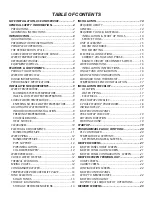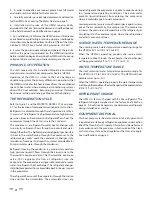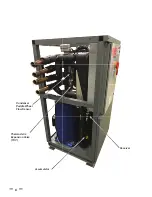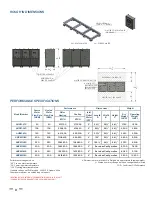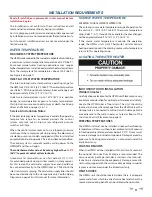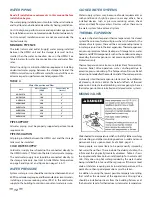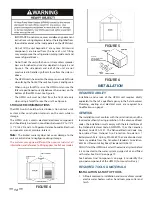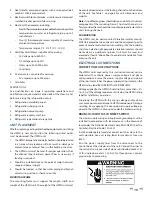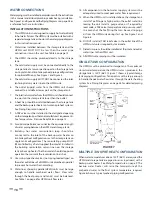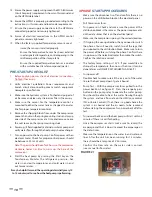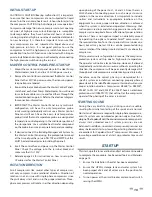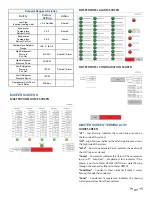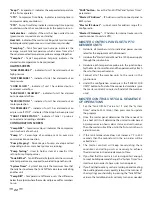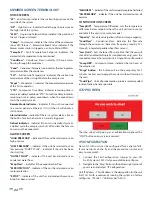
9
SOURCE WATER TEMPERATURE
ENTERING SOURCE WATER TEMPERATURE
The entering source water temperature range of operation for
the unit is 40° - 100°F (4.4°C to 38°C). The source temperature
drop (Delta T - ΔT) through the evaporator (heat exchanger)
will be approximately 8°F to 12°F (-13°C to -12°C).
If the source water temperature is outside this operating
range the HPWH unit’s Limit Thermostat will discontinue
heating operation until the entering source water temperature
returns to this operating range.
LOCATING THE WATER HEATER
INDOOR/OUTDOOR INSTALLATION
(Milder Climates)
Carefully choose a location for the HPWH unit. Placement is a very
important consideration for optimal performance and safety.
Locate the HPWH near a floor drain. The unit should be
located in an area where leakage from the HPWH unit or the
storage tank it is connected to will not result in damage to the
area adjacent to the water heater or to lower floors of the
structure. See Unit Placement on page 15.
FREEZING TEMPERATURES
The HPWH unit must not be installed in space where freezing
temperature will occur, without a low ambient air kit. Exposure
to freezing ambient temperatures below 32°F (0° C) may result
in severe damage to internal components. Damage caused by
exposure to freezing temperatures is not covered under the
limited warranty.
COASTAL REGIONS
When the HPWH will be installed within 5 miles of a seacoast
the optional Corrosive Duty Package is recommended. The
corrosive duty package includes a stainless steel cabinet,
(Ecoating is standard on the evaporator). Damage caused to
units not equipped with the corrosive duty package in coastal
regions is not covered under the limited warranty.
HEAT SOURCE
The HPWH unit should be located where there is adequate
source water from which to extract waste heat and where the
source water cooling benefi t can be utilized when possible.
INSTALLATION REQUIREMENTS
Read all installation requirements in this manual before
installation begins.
The installation must conform to these instructions and all
local and national code authority having jurisdiction.
Costs to diagnose, perform service and repair damage caused
by installation errors are not covered under the limited warranty.
Costs to correct installation errors are not covered under the
limited warranty.
WATER TEMPERATURE
MAXIMUM SYSTEM TEMPERATURE
The HPWH units covered in this manual are capable of maintaining
a maximum system/storage tank temperature of 150°F (66°C).
Some commercial water heating applications may require
higher temperatures. Install a booster water heater downstream
from the storage tank for temperatures above 150°F (66°C).
See Figure 8 on page 17.
INLET & OUTLET WATER TEMPERATURE
The inlet (entering) water temperature operating range for
the HPWH is 40°F to 140°F (4.4°C to 60°C). The water temperature
rise (Delta T - ΔT) through the condenser (heat exchanger) will
be approximately 8°F to 12°F (4°C to 7°C).
Outlet water temperatures up to 152°F (67°C) are possible
during normal operation. Exposure to water temperatures
this high can cause serious bodily injury or death. See Mixing
Valves and Table 5 on pages 12 & 13.
Service & Installation Notes:
If the inlet (entering) water temperature is outside the operating
temperature range for extended periods the control
system may lock out on high or low refrigerant pressure
switch events/trips.
When the control system locks out on a refrigerant pressure
switch event the compressor will stop running, the blower and
circulation pump (on models equipped with factory installed
pump) will continue to operate. This is a hard lock out condition.
The control system is manually reset by cycling power to the
HPWH off and then on again.
The tank thermostat must not be set any higher than
150°F
(66°C) to prevent control system lock outs.
Ground water temperatures can fall below 50°F (10°C)
for extended periods during winter months in many regions.
For this reason the cold water supply lines and should not
be connected directly to the HPWH inlet or T fi tted into the
inlet (return) water piping. The cold water supply lines should
be connected directly to the storage tank only. See the Piping
Diagrams on page 28 in this manual for more information.
Summary of Contents for AHPM-270
Page 2: ......
Page 10: ...6 Thermostatic Expansion Valve TXV Condenser Paddle Wheel Flow Sensor Accumulator Receiver...
Page 11: ...7 WATER TO WATER CYCLE...
Page 40: ...36 Service Log Issue Description Date Servicer...
Page 41: ...Service Log Issue Description Date Servicer 37...
Page 42: ...Notes 38...
Page 43: ......
Page 44: ......



